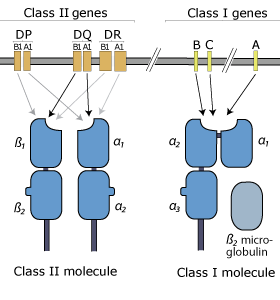HLA genes and moleculesThe MHC is characterized by its polygeny (which means that different genes encode for different MHC molecules). In total, there are 3 functional class I genes (HLA-A, HLA-B and HLA-C) and 9 functional class II genes (HLA-DRA, HLA-DRB1, HLA-DRB3, HLA-DRB4, HLA-DRB5, HLA-DQA1, HLA-DQB1, HLA-DPA1 and HLA-DPB1).
Class I genesEach of the three HLA class I genes (A, B and C) encodes for an α-chain of the MHC class I molecule. The β2-microglobulin is encoded by a gene out of the HLA system. Class II genesEach of the class II antigens (DP, DQ, DR) is encoded by an α-chain-gene (A1) and by a β-chain-gene (B1). The α and β chains pair to form the functional HLA molecule. Most individuals carry an additional DRB gene (DRB3 or DRB4 or DRB5) which code for a different β-chain that may pair with the α-chain. High polymorphism is a consequence of polygeny and codominanceThe loci coding class I and II molecules display the highest level of variation found in human genome. MHC form a cluster of genes which is generally inherited as a complete set, called haplotype, from each parent. MHC genes are characterized by a codominant expression. Thus, with three MHC class I genes and depending on the number of DRB genes on each chromosome 6, an individual typically expresses six different MHC class I molecules and from six to eight different MHC class II molecules. Heterozygous individuals may therefore express a maximum of 14 different HLA class I and class II antigens. |
|
|
Transplantation Immunology | |||||||||||||||||||
|
||||||||||||||||||||



 Print
Print